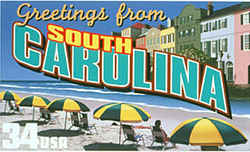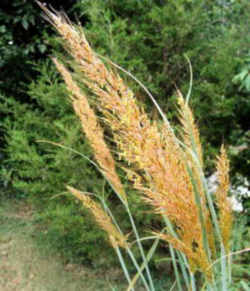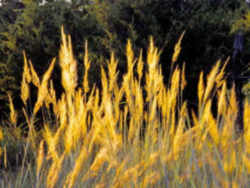
South Carolina Symbols
South Carolina State Grass
Indian Grass

(Sorghastrum nutans)
Adopted on August 29, 2001.
Indian Grass, (Sorghastrum nutans,) was designated as the official Grass of the State by Act 94, on August 29, 2001.
The genus Sorghastrum has a Greek origin and means "a poor imitation of sorghum." The species name nutans, from Latin, means "nodding" or "swaying," an apt description of a plant often seen in large numbers swaying in the wind. Other common names for this plant include bushy bluestem, wood grass, wild oatgrass, and yellow Indian grass.
South Carolina State Grass: Indian Grass

Indian grass is adapted to a wide part of our country, from the Northeast, west into the high plains, Great Plains, and south to Texas. As most any grass, it grows best in deep, well-drained soils, but can be found growing on poor sand to wet clay soils. Indiangrass is a warm season grass (that term means: a grass that does not begin its growth in the spring until the soil temperature is above 50 -55 degrees and it achieves 80% of its growth in June, July and August). This grass is important to the tall-grass prairie and is a favorite food of grazing livestock. It is also hardy and can live through flooding and repeated fires.
This grass typically grows 3 to 5 feet tall, though it can reach heights of nearly 7 feet. It generally occurs in dense tufts, but it is sometimes found as single stems. Individual flowers are inconspicuous, but the pollen is produced on protruding bright yellow stamens. The fall seed heads are an attractive chestnut brown color and feel silky smooth when you run your hands gently along them. Indian grass can be identified even without the flowering stalks by the distinctive "ligule," which looks like a pair of erect, narrow, pointed lobes at the point where the leaf blade joins the stem; some people call these "rabbit ears."
- Culm: Perennial erect, hollow, tall grass, 3 - 7 feet tall, nodes are fuzzy pubescent.
- Blades: Flat, 12 to 24 inches long, .2 to .5 inch wide, pointed, taper to a narrow base, very rough, often glaucous, prominent midrib near the base.
- Sheath: Upper shorter than the internodes, usually smooth and glabrous. Very prominent "rabbit ear" auricles.
- Ligule: Membranous, thick, stiff, 2 to 4 mm long, flanked by pointed auricles.
- Inflorescence: Narrow, oblong panicles, 6 to 12 inches long, that are large, dense and bronze-yellow. The apex is often nodding. At first the panicles are open, but are contracted and darker after flowering. The spikelets are born in pairs.
- Spikelets: Paired. Sessile spikelets hirsute 6 to 8 mm long, lanceolate, nearly circular in cross-section, perfect. Pedicellate spikelet represented merely by a hairy pedicel at one side of the sessile spikelet. The spikelets droop, are yellowish to reddish brown and covered with reddish brown hairs toward the base.
- Awns: The .5 inch awn is bent and is twisted up to the bending point. The awn is longer than the spikelet.
South Carolina Act 94
(A94, R143, H4015)
AN ACT TO AMEND THE CODE OF LAWS OF SOUTH CAROLINA, 1976, BY ADDING SECTION 1-1-693 SO AS TO DESIGNATE PORGY AND BESS AS THE OFFICIAL OPERA OF THIS
STATE AND TO PROVIDE THAT COPYRIGHTED OR PROPRIETARY MATERIAL FROM PORGY AND BESS MAY NOT BE USED WITHOUT CERTAIN WRITTEN PERMISSION; AND TO ADD SECTION
1-1-677 SO AS TO DESIGNATE INDIAN GRASS (SORGHASTRUM NUTANS) AS THE OFFICIAL GRASS OF THE STATE OF SOUTH CAROLINA, AND TO PROVIDE FOR CERTAIN LIMITATIONS
ON THIS DESIGNATION.
Be it enacted by the General Assembly of the State of South Carolina:
Porgy and Bess as official state opera; limitation on use
SECTION 1. The 1976 Code is amended by adding:
"Section 1-1-693. Porgy and Bess is designated as the official opera of this State. The State and any of its agencies, departments, or political subdivisions
may not use any copyrighted or proprietary material from Porgy and Bess without the express written permission from the estates of Dubose Heyward,
George Gershwin, and Ira Gershwin or the management company responsible for licensing productions of this opera in part or in its entirety."
Indian Grass official state grass; limitation on designation
SECTION 2. The 1976 Code is amended by adding:
"Section 1-1-677. Indian Grass, Sorghastrum nutans, is designated as the official grass of the State. In making this designation, the General Assembly
makes no warranty or endorsement of Indian Grass as a commercial product, but recognizes Indian Grass as a native, nonnoxious plant, with a historical,
continuing, widespread, and beneficial existence in South Carolina."
Time effective
SECTION 3. This act takes effect upon approval by the Governor.
Ratified the 7th day of June, 2001.
Approved the 29th day of August, 2001.
South Carolina Law
The law designating Indiana grass as the official South Carolina state grass is found in the South Carolina Code of Laws, Title 1, Chapter 1, Article 9, Section 1-1-677.
Title 1 - Administration of the Government
CHAPTER 1. GENERAL PROVISIONS
ARTICLE 9. STATE EMBLEMS, PLEDGE TO STATE FLAG, OFFICIAL OBSERVANCES
SECTION 1-1-677.
SECTION 1-1-677. Official State grass.
Indian Grass, Sorghastrum nutans, is designated as the official grass of the State. In making this designation, the General Assembly makes no warranty
or endorsement of Indian Grass as a commercial product, but recognizes Indian Grass as a native, nonnoxious plant, with a historical, continuing, widespread,
and beneficial existence in South Carolina.
Taxonomic Hierarchy: Indiana Grass
Kingdom: Plantae - Plants
Subkingdom: Tracheobionta - Vascular plants
Superdivision: Spermatophyta - Seed plants
Division: Magnoliophyta - Flowering plants
Class: Liliopsida - Monocotyledons
Subclass: Commelinidae
Order: Cyperales
Family: Poaceae ⁄ Gramineae - Grass family
Genus: Sorghastrum Nash - Indiangrass
Species: Sorghastrum nutans (L.) Nash - Indiangrass







